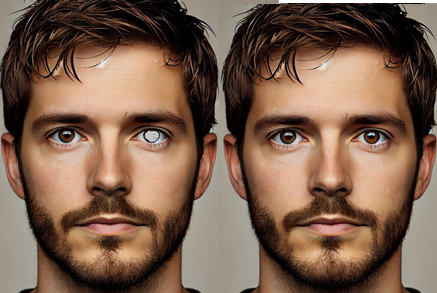“After infections, eye injuries, and certain surgeries, unsightly spots may form on the eye, which are noticeable when viewed from the outside. These individuals may have partially or completely lost their vision. Additionally, congenital, traumatic, or surgical causes can lead to defects in the iris, which can result in glare. In such cases, we can achieve both aesthetic and even functional improvement by applying pigment to the cornea. This method, known as keratopigmentation or corneal tattooing, has been successfully practiced at our hospital for many years.
As shown in the image

, white spots can appear on the front surface of the eye for various reasons. These spots may be due to past infections, injuries, or other causes. These spots not only affect vision but also create aesthetic and psychological problems in those who have lost their sight. To cover these white spots and provide individuals with a more aesthetic appearance, corneal tattooing can be applied to suitable eyes. Our doctors are highly experienced in this area. Unfortunately, it is not possible for us to share before and after photos of patients.
If you have a spot on your cornea that bothers you, you can consult with the doctors at our hospital.
Below, you can find more information about keratopigmentation (corneal tattooing):
Keratopigmentationis a surgical procedure used to change the color of the cornea. This procedure can be performed for both cosmetic and medical purposes. The details of the procedure and the reasons for its application are as follows:
Medical Reasons: Keratopigmentation can also be used in the treatment of various eye diseases. Some medical conditions and injuries can cause visual defects in the eye, and in such cases, keratopigmentation can provide both aesthetic and functional improvement. The main applications of keratopigmentation for medical reasons include:
– Absence of Iris (Aniridia): In individuals with congenital or trauma-induced iris deficiency, light control in the eye is disrupted. Keratopigmentation can improve light control by adjusting the eye color.
– Aesthetic Disorders After Trauma or Surgery: Aesthetic disorders that occur after eye surgeries or injuries can be corrected with keratopigmentation. – Cosmetic Masking: It can be used to conceal visual defects caused by certain eye diseases.
Cosmetic Reasons:
Keratopigmentation can be preferred by individuals who wish to change their eye color for aesthetic purposes. Some people may be dissatisfied with their natural eye color and may want to change it permanently. In such cases, keratopigmentation may be an option.
Application Methods:
– Pigment Injection (FLAAK method): Color change is achieved by injecting special pigments into the cornea. This method requires a highly delicate procedure and is usually performed under local anesthesia. – Femto-laser Assisted Pigmentation: Micro-channels are created in the cornea using a femto-laser, and pigments are placed in these channels. This method provides a more precise and controlled application.
Risks and Side Effects:
Keratopigmentation may have some risks and side effects. Therefore, careful evaluation before the procedure is important. Potential risks may include:
Conclusion:
Keratopigmentation is a procedure used to permanently change eye color for both cosmetic and medical reasons. This procedure offers an effective solution for aesthetic improvement and the treatment of certain eye diseases. However, the risks and potential side effects of the procedure should be considered, and it should be performed by an experienced ophthalmologist.”
Son Güncelleme 30 October 2024 Saat 15:21 pm














